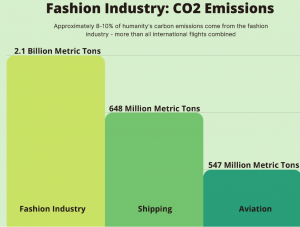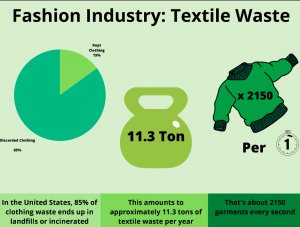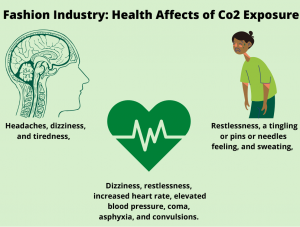Researchers expect that climate change will cause irreversible damage in approximately 11 more years. But there are ways to prevent this from happening and the first step starts with your closet. As the fashion industry is one of the leading contributors to the climate change crisis.
Rebecca Miller a junior social work major at Bradley University, Warren Thielbar a junior accounting major at Bradley University, and Micki Roy a manager at Hollister and EDK all stated that they go shopping one to three times a week. Stores ranged from Walmart and Target to Shein and local boutiques.
“I only know the environmental impact and sustainability clauses for certain brands,” Roy said.
Well, before the clothing can be sold in stores it has to be produced and transported. During the production process, garments are cut, dyed, and sewn. Every year, 93 billion cubic meters of water are used by the fabric industry. According to Geneva Environment Network, about 20% of industrial wastewater pollution stems from fast fashion.
Those polluted waters carry ships from continent to continent to deliver textiles. Factories combined with these ships have led the fashion industry to produce 8-10% of carbon emissions.
In the process of accumulating many new garments of clothing, the older ones tend to be discarded.
“ I pack up my unwanted clothing and either throw it away or donate it to thrift shops,” Miller said.
Roy and Thielbar had a similar mentality when it came to discarding their clothing as well. But, the way you dispose of your clothing has a big impact on the environment. Most donated clothing is discarded, with only 10-20% deemed acceptable and resold. This causes 85% of clothing to end up in landfills or incinerated each year. According to bloomberg.com, this equates to approximately 11.3 tons of textile waste meaning that every second that goes by 2,150 garments are disposed of.
In landfills, these garments can take as long as 200+ years to decompose. Textiles produce methane gas during this time and absorb chemicals and dyes into the soil and groundwater. Given that 115 million Americans depend on groundwater for drinking, this is a major concern.
Pollution from the fashion industry not only has severe effects on the environment but also on human health.
Clothing incinerators emit CO2, methane, and other greenhouse gases, which can degrade air quality resulting in climate change and health issues. When these garments are burned, the toxins are emitted into the air, or ash is produced. It is possible to have difficulty breathing, increased heart rate, elevated blood pressure, and convulsions from exposure to CO2.
“I have no idea about sustainability and I don’t typically go out of my way to research it,” Thielbar said.
Now would be the time to begin to conduct your own research to help prevent irreversible climate damage and protect your health. As stated in the beginning, the first step begins with your closet. To begin reducing your impact on the environment you can attend clothing swaps, upcycle old clothes, wash your clothes less, research brand/company’s sustainability policies, and buy garments made from organic or recycled materials.


